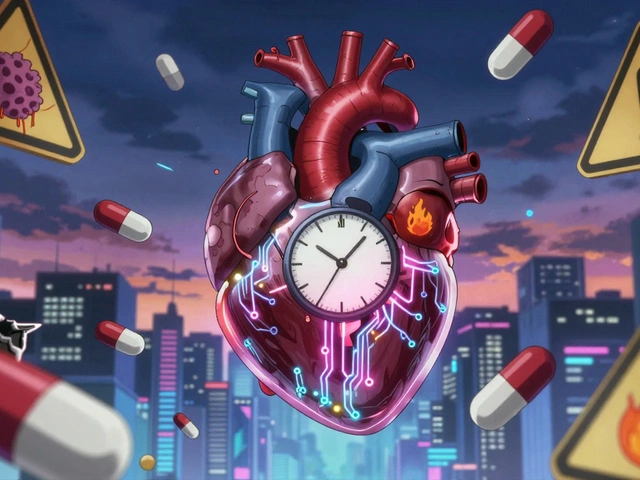Managing multiple medications can feel overwhelming. You’ve got pills for your blood pressure, your diabetes, your cholesterol, maybe a pain reliever, a vitamin, and something for your sleep. And you’re not sure if you’re taking them at the right time, or if they interact with each other. You’ve missed doses before. You’ve forgotten why you even take one of them. You’re not alone. But there’s a simple, powerful tool that can change this: a medication action plan.
What Exactly Is a Medication Action Plan?
A medication action plan (MAP) isn’t just a list of your drugs. It’s a personalized roadmap created with your care team-your doctor, pharmacist, nurse, or care coordinator-that tells you exactly what to do, when, and why. It turns confusing instructions into clear, daily steps you can follow.Think of it like a GPS for your meds. Instead of guessing whether to take your pill before or after breakfast, your plan says: “Take metformin with your morning coffee.” Instead of wondering if that new headache medicine is safe with your blood thinner, your plan flags it and tells you what to do instead.
These plans are backed by real data. In the U.S., Medicare Part D has required medication therapy management (MTM) programs since 2006, and the medication action plan is one of its five core parts. Studies show patients who use personalized MAPs improve their adherence by 25-40%. That means fewer hospital visits, fewer bad reactions, and more control over your health.
Why Most Medication Lists Fail
You’ve probably seen those little paper lists people carry in their wallets: “Lisinopril 10mg, Atorvastatin 20mg, Metformin 500mg.” That’s not a plan. That’s a receipt. And it doesn’t help if you don’t know why you’re taking them or what to do if you feel sick.A 2022 study from the University of Michigan found that 43% of patients eligible for a medication action plan never received one. And when they did get one, many were generic templates filled with medical jargon-words like “hypertension” or “hyperlipidemia”-that patients didn’t understand.
One 68-year-old woman in Florida had diabetes and took seven medications. Her old list said “take insulin at breakfast.” But she didn’t eat breakfast. She drank coffee at 10 a.m. Her plan didn’t match her life. So she made her own: she glued pictures of each pill next to photos of her coffee cup, lunch plate, and bedtime lamp. She stuck it on the fridge. Her adherence jumped from 65% to 95%.
That’s the difference: a plan that fits your life, not one that forces you to fit into a system.
Who Should Have a Medication Action Plan?
You don’t need to be elderly or in poor health to benefit. If you take three or more prescription medications regularly, or if you’re managing a chronic condition like diabetes, heart disease, COPD, or depression, you’re a perfect candidate.Medicare Part D patients who take eight or more chronic meds and spend over $4,430 a year on them are automatically eligible for a free MTM session-including a MAP. But you don’t need Medicare. Many private insurers, employer plans, and even some pharmacies now offer this service for free.
Parents of children with asthma, epilepsy, or severe allergies also need MAPs. These plans are used at school, during travel, and at home. One parent told me her son’s plan had a photo of his inhaler next to the school bell schedule. “Now the nurse knows exactly when to give it,” she said.
How to Start: What to Bring to Your Appointment
You don’t wait for your doctor to offer this. You ask for it. Say: “Can we make a medication action plan together?”Before your appointment, gather everything you take:
- All prescription medications (in original bottles if possible)
- All over-the-counter pills (pain relievers, antacids, sleep aids)
- Vitamins, minerals, and supplements (even the ones you take “just because”)
- Herbal teas or remedies (like turmeric, ginseng, or St. John’s wort)
- A list of any allergies or bad reactions you’ve had
- Your biggest questions: “Why do I take this?” “What happens if I miss a dose?” “Can I take this with grapefruit?”
Don’t worry if you don’t have all the bottles. Write down names, doses, and how often you take them. Even a rough list is better than nothing.
The 5-Step Process to Build Your Plan
Here’s how it actually works, step by step:- Review everything together. Your pharmacist or doctor will go through every item you brought. They’ll check for duplicates (like taking two different painkillers with the same active ingredient), dangerous interactions, or pills you no longer need.
- Identify your biggest problems. What’s really tripping you up? Forgetting doses? Side effects? Cost? Confusion? Say it out loud. “I always forget my evening pill.” “I get dizzy after my blood pressure med.” “I don’t know if I should take this if I feel sick.”
- Set one or two clear goals. Don’t try to fix everything at once. Pick one area to improve. Example: “I want to take all my evening pills 9 out of 10 nights for the next month.”
- Build your action steps. This is where it gets personal. Your plan should say exactly what to do. Not “take medication as directed.” But: “Place your evening pills in a small cup next to your toothbrush. Take them right after brushing your teeth.” Or: “If you feel dizzy after your blood pressure pill, sit down for 10 minutes, then drink a glass of water. Call your doctor if it happens three days in a row.”
- Make it visible and simple. Write it on paper. Use color coding: red for heart meds, green for diabetes, blue for pain. Add icons-coffee cup for morning, moon for night. Take a photo of it on your phone. Stick it on your fridge. Put it in your wallet. Make it impossible to ignore.
What Makes a Good Medication Action Plan?
The best plans have three things:- Personalized-It matches your daily rhythm, not a hospital schedule.
- Action-oriented-It tells you what to DO, not just what to know.
- Measurable-You can track it. “Take 90% of doses” is better than “Try to take them.”
And it’s not a one-time thing. Your plan should change when your meds change. If your doctor adds a new pill, or you stop one, update the plan. Keep it with you. Bring it to every appointment-even if it’s just for a cold.

What If Your Care Team Doesn’t Offer This?
Many doctors don’t bring it up. But pharmacists often do. Walk into your pharmacy and ask: “Can you help me make a medication action plan?” Most community pharmacies in the U.S. now offer this for free, especially if you’re on Medicare or have a chronic condition.If you’re not on Medicare, check with your private insurer. Many employer plans now cover MTM services. Even if they don’t, pharmacists can still help you build a plan-they just might not document it officially. Ask for a printed copy. Ask for it in plain language. Say: “I need this to be easy to understand, not full of medical terms.”
If you’re still stuck, call your local Area Agency on Aging or community health center. They often have patient navigators who help people create these plans.
Real Results: What Happens When You Use It
People who use a real medication action plan report:- 70% less confusion about when and why to take their pills
- 32% fewer medication-related hospital visits in the next year
- More confidence talking to their doctors
- Less fear of side effects because they know what to watch for
One man in Texas took six meds for heart disease and diabetes. He kept ending up in the ER because he didn’t know what to do when his legs swelled. His MAP added: “If your ankles swell more than usual, check your salt intake. Skip your next diuretic dose and call your doctor the same day.” He hasn’t been back to the ER in 14 months.
Final Thought: This Is Your Health, Not a Checklist
A medication action plan isn’t about being perfect. It’s about being prepared. It’s about turning fear into control. It’s about knowing that when you feel off, you have a clear next step-not a pile of pills and a feeling of guilt.You’re not just managing meds. You’re managing your life. And you don’t have to do it alone. Your care team is there to help you build something that works for you. Ask for it. Write it down. Stick it where you’ll see it. And update it every time something changes.
Your health deserves more than a list. It deserves a plan.
Do I need a doctor to make a medication action plan?
No, you don’t need a doctor to start. Pharmacists are trained to help you build a medication action plan and often have more time to walk through your meds than doctors do. You can begin with your pharmacist, then bring the plan to your doctor for approval. Many plans are co-created between both.
Can I use a phone app instead of paper?
Yes, many apps now sync with your medication action plan and send reminders. But don’t rely on apps alone. Always have a printed copy you can show to a nurse, doctor, or paramedic in an emergency. Apps can fail, phones can die. Paper never does.
What if I can’t read or have trouble understanding medical terms?
Ask for your plan in plain language. Say: “Use words I know.” Many pharmacies use visual plans with pictures of pills, clocks, and daily activities. You can also ask a family member, friend, or community health worker to help you read and understand it. Your plan should make sense to YOU, not just to a doctor.
How often should I update my plan?
Update it every time your meds change-whether it’s a new prescription, a dose change, or you stop one. Even if nothing changes, review it every three months. Ask yourself: “Is this still working? Is anything confusing now?”
Is this only for older adults?
No. Anyone taking three or more medications regularly can benefit-teenagers with asthma, young adults with depression, people recovering from surgery. It’s not about age. It’s about complexity. If your meds feel like a puzzle, you need a plan.
Will my insurance pay for this?
Medicare Part D covers it for eligible patients. Many private insurers do too, especially if you have chronic conditions. Call your insurance provider and ask: “Do you cover Medication Therapy Management (MTM)?” If yes, ask how to schedule your free session. If no, ask your pharmacy-they may still offer it for free.





akhilesh jha
November 25, 2025 AT 03:33Been using a handwritten map with sticky notes for my dad's meds. Glued pics of his coffee cup next to the insulin. He forgets less now. No app beats a visual cue you can't ignore.
Jeff Hicken
November 27, 2025 AT 00:46why do we even need this? my doctor just says 'take it' and i do. if i forget, i guess i'm just lazy. this feels like overkill.
Yvonne Franklin
November 27, 2025 AT 08:52Pharmacies in Canada have been doing this for years. Ask for MTM. No cost. No drama. Just a 20-min chat and a printed plan. Seriously, do it.
Neoma Geoghegan
November 27, 2025 AT 16:16MAPs are game changers. My aunt went from 40% adherence to 92% after her pharmacist sat down with her and mapped it to her tea time and TV schedule. No jargon. Just pictures and plain words. She's alive because of it.
Andy Louis-Charles
November 29, 2025 AT 12:03Used a free app + printed copy. The app reminds me, but I keep the paper in my wallet. Last ER trip, the nurse grabbed it before I even spoke. Saved my life. 💯
Douglas cardoza
November 30, 2025 AT 16:07my mom’s plan has emojis. 💊☕🌙. she says it’s the only thing that sticks. i laughed at first but now i’m stealing the idea. simple works.
Adam Hainsfurther
December 1, 2025 AT 17:24In my village in rural Ohio, the local pharmacist makes these by hand on index cards. No computers. Just pen, photos, and a smile. People trust it more than anything digital. Culture matters. Paper doesn’t glitch.
Rachael Gallagher
December 3, 2025 AT 15:43They’re just trying to control you. Next they’ll tell you when to breathe. This is Big Pharma’s new marketing gimmick wrapped in ‘healthcare’.
steven patiño palacio
December 5, 2025 AT 06:32One of the most practical health tools I’ve ever seen. My father’s MAP included a color-coded chart with his daily routine. When he had a stroke, the paramedics saw it and knew exactly what meds to avoid. It’s not just helpful-it’s lifesaving.
stephanie Hill
December 6, 2025 AT 11:53They’re tracking you. Every pill. Every time. This ‘plan’ is just the first step. Next thing you know, your insurance will cut off your meds if you miss a dose. They’re building a database. Don’t sign up.
Akash Chopda
December 8, 2025 AT 06:04Why not just use a pillbox? This is too much. They want you dependent on paper. I trust my memory.
Sam Jepsen
December 9, 2025 AT 04:16My niece with epilepsy has her MAP taped to her laptop. School nurse, babysitter, even her dog walker knows what to do. She’s had zero seizures since. This isn’t just a plan-it’s a safety net.
Bartholemy Tuite
December 11, 2025 AT 01:21Look, I’m Irish and I’ve seen this work. My gran had eight meds, couldn’t read, and didn’t trust doctors. Her grandson made her a plan with photos of her favorite chair, her kettle, and the TV remote. She took her meds like clockwork. Took her 30 minutes. No fancy tech. Just love and a printer. I cried. You don’t need a degree to make this work-you just need to care enough to try.